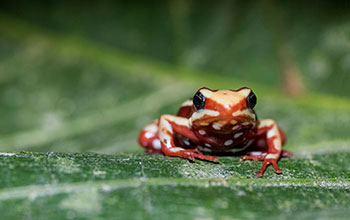Multimedia Gallery
Why poison frogs don’t poison themselves
The phantasmal poison frog Epipedobates anthonyi is the original source of epibatidine, discovered by John Daly in 1974. Epibatidine has not been found in any animal outside of Ecuador, and its ultimate source, proposed to be an arthropod, remains unknown. This frog was captured at a banana plantation in the Azuay province in southern Ecuador.
More about this image
Although tiny, dappled in cheerful colors and squishy, poison frogs in fact harbor some of the most potent neurotoxins known to man. Now, researchers from The University of Texas at Austin (UT Austin) are a step closer to answering the question: How do these frogs keep from poisoning themselves? The answer has potential consequences in the fight against pain and addiction.
The research answers this question for a subgroup of poison frogs that use the toxin epibatidine. The frogs use the toxin to keep predators from eating them. Epibatidine binds to receptors in an animal's nervous system and can cause hypertension, seizures and even death.
The researchers found a small genetic mutation in the frogs -- a change in just three of the 2,500 amino acids that make up the receptor -- prevents the toxin from acting on the frogs' own receptors, making them resistant to its lethal effects. They found that precisely the same change appeared independently three times in the evolution of these frogs.
"Being toxic can be good for your survival -- it gives you an edge over predators," said Rebecca Tarvin, a postdoctoral researcher at UT Austin and a co-first author on the published study. "So why aren’t more animals toxic? Our work is showing that a big constraint is whether organisms can evolve resistance to their own toxins. We found evolution has hit upon this same exact change in three different groups of frogs, and that, to me, is quite beautiful."
Read more about this research in the UT Austin news story Why Poison Frogs Don’t Poison Themselves. (Date image taken: August 2017; date originally posted to NSF Multimedia Gallery: July 20, 2018)
Credit: Rebecca Tarvin/University of Texas at Austin
See other images like this on your iPhone or iPad download NSF Science Zone on the Apple App Store.
Images and other media in the National Science Foundation Multimedia Gallery are available for use in print and electronic material by NSF employees, members of the media, university staff, teachers and the general public. All media in the gallery are intended for personal, educational and nonprofit/non-commercial use only.
Images credited to the National Science Foundation, a federal agency, are in the public domain. The images were created by employees of the United States Government as part of their official duties or prepared by contractors as "works for hire" for NSF. You may freely use NSF-credited images and, at your discretion, credit NSF with a "Courtesy: National Science Foundation" notation.
Additional information about general usage can be found in Conditions.
Also Available:
Download the high-resolution JPG version of the image. (8.9 MB)
Use your mouse to right-click (Mac users may need to Ctrl-click) the link above and choose the option that will save the file or target to your computer.



